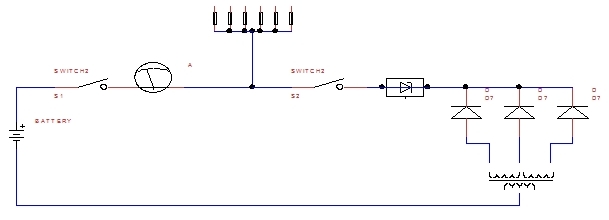Electrical system
A helicopter’s electrical system serves many electrical sub-systems. It is used
to safely power avionics, store electrical energy with which to power up the engine,
operate actuators, and power internal and external lights, fans, etc. The electrical
systems differ greatly in complexity
between helicopter models. The basic concepts thereof do, however, remain the same.
When the engine is running, the electrical power is generated by the alternator.
This is a device which converts mechanical energy (provided by a rotating shaft) into electrical energy by rotating a magnetic field which generates
a changing flux
in the alternator’s coils. The alternator generates a three phased
alternating voltage (which means that
three coils are used to generate current).
This must first be rectified before it can be used in the DC electrical system. The use of a three
phased system (instead of one of one or two) results in a smoother
rectified voltage.
The rectification is carried out by diodes, which are often incorporated in the alternating
unit. As the rectifying diodes are small devices and also dissipate power, they usually
get rather hot. Measures must be taken to dispose of this heat.

The generated power is also used to charge the battery (to store electrical energy
for later use). This is done by a device called the regulator.
The batteries used are either 12V (mainly in light helicopters) or 24V. Before the DC current is fed into the electrical system, it
must pass through a circuit breaker.
It is common practice to group the electrical
system into sub-systems, each secured by one circuit breaker. This makes the overall
electrical system more robust, because
if a sub-system contains a fault, it can be isolated.
Larger helicopters use an AC system at a frequency of 400Hz, instead of the more commonly used
50/60Hz arrangement. The
reason for the utilisation of this higher frequency is that it means electrical
equipment with less mass can be designed.
Next topic > Hydraulic System
|
Cyclic & Collective
- The title of this book leads me to wonder what more it will teach me in addition to its content about these two, most frequently used, helicopter input controls. As it turns out, the answer is: a lot more. Of course, all of the obligatory subjects like basic physics, rotor aerodynamics and helicopter performance are dealt with as well, as are piston engine and basic helicopter manoeuvres. Yet the scope of this book is actually much wider than one might initially think.
Firstly, it is divided into a 'beginners’ and an 'advanced’ section. This means that the book can treat more complex concepts in depth, even though the focus in the first section is directed more towards newcomers to the field.
Secondly, subjects like turbine engines, multi-engine helicopters and autopilots are also examined. This is particularly helpful, since these topics are not usually covered in the majority of helicopter books aimed at this target audience.
Thirdly, the book deals with many things that you will not normally find in a text book: helicopter related experiences and a great deal of interesting detail. This is the sort of information that can only be provided if you have flown a lot of different helicopters and have been working in this industry for some time. What’s more, this tone is amplified by the consistently narrative style of the book.
- 536 pages
|
|
Art of the Helicopter (Hardback)
- Well structured text that covers many technical aspects. It starts with an introduction to helicopters, followed by a treatment of
the technical background needed when studying them. Thereafter, dynamics, rotor systems, engines and transmission are explained in detail.
The book concludes with a section on performance and other types of rotorcraft. Its main asset is that the text is technically and
theoretically very accurate, and rather than mathematics, its focus is always on enabling the reader to achieve an understanding of
helicopters from a technical or engineering point of view. The more technically orientated reader will love this work.
- 416 pages
|
|
Principles of Helicopter Flight (Paperback)
- If you are wondering how a helicopter flies, and really want to comprehend the process, you have no choice but to delve into
aerodynamics. This means not only understanding which forces play a role and the laws of physics, but also being able to put it all
together and apply your knowledge to a rotating system consisting of a number of rotor blades. This is a demanding task and requires
some very hard work. It is, undoubtedly, worth the effort though, and will help you to become a better pilot. There are many books out
there to help you with this task of exploring the principles of helicopter flight, but they tend to fall into two camps:
populist and taking a rather simplistic approach, or highly technical and assuming the reader has a degree in mathematics.
This book is different, because it clearly explains the principles of flight in a step by step way that is easy for most
readers to follow. Further benefits are that a lot of attention is paid to flight manoeuvres and operations, and every chapter
concludes with questions as a study aid.
- 320 pages
|
Comments are disabled.